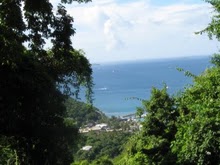 |
| American Restart male |
In August of this year I went to explore another new area in the city that is only about three blocks away from my present residence. It is a forested area that is actually quite large and has a creek running through it. I was amazed at how many different trails wind their way through it and I realized soon enough that it would take more than one trip to explore. As is typical when I explore a new place, I simply enjoyed the experience, stopping here and there to examine wild flowers, berries, mushrooms, and the creek itself and in so doing also absorbing the peace that nature provides.

About halfway through, sticking to the main trail which was just curving upward, I saw a flash of red amongst the green in some trees next to the trail. I stopped and waited, camera ready, but for a few minutes there I thought I would not see it again. Then suddenly I saw several different birds all at once. The flash of red I had seen belonged to an American Redstart male in full courting plumage, who was joined by a female and several other species of flycatchers. Now as it happened they were seeking food underneath the leaves of the tree they occupied, making it difficult to catch sight of them, but luckily I had my camera set on a fast shutter speed.
 |
| Female |
 |
| American Redstart female |
|
When I got home and viewed my pictures I was delighted. As you can see from my picture at the top of this post, the American Redstart male, when in courting color is as bright as a butterfly with its red and orange colored wings, white belly, black head and back. In fact it is often called the butterfly of birds. The female of the species is also brightly and beautifully marked during the breeding season as you can see above. As is often the case with some species of birds, they appear quite different when not courting a mate and as it happens, I also managed to get pictures of a juvenile American Redstart sometime later, which is colored like a non-breeding female. Juveniles will retain this color until their second year.
 |
| American Redstart Juvenile |
 |
| Juvenile |
The American Redstart can be recognized by it's flashing tail which contains a streak of orange or red, depending on the season. It flashes it's tail and wings to startle and flush out insects, which are it's primary food source. In fact, it often holds it's tail partly fanned out. It will also hunt for the insects hidden underneath the leaves of trees and bushes. Insects, however, are not all that it's diet consist of, as it also eats fruit, berries and seeds.
 |
| Redstart male in flight |
This is a very fast and active bird, let me tell you and
the soft chipping sound that it makes, especially when feeding, is quite distinctive. I have learned since, that it is a new world warbler who prefers open and second growth woodland. The males can be aggressive, especially when establishing their breeding territories, and often have two mates. American Redstarts are also
migratory birds
, which can be found in the Caribbean, Central America, South America, the West Indies and sometimes, but rarely in Europe in winter. Their summer range is North America and most of Canada, as well as the eastern United States. I will certainly be looking forward to seeing this bird again in the spring.
Enjoy,
Susan



















No comments:
Post a Comment